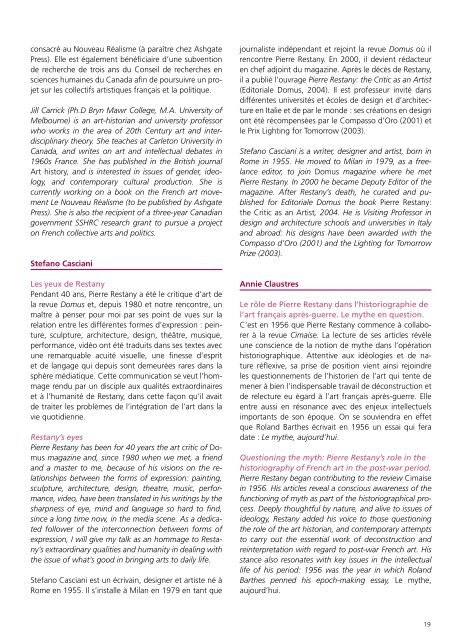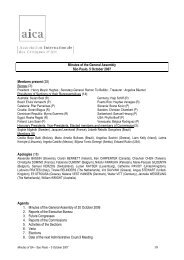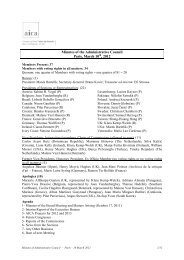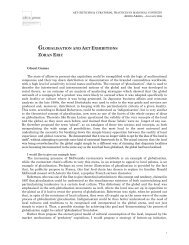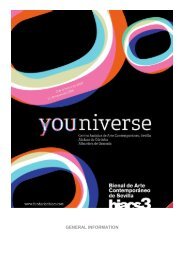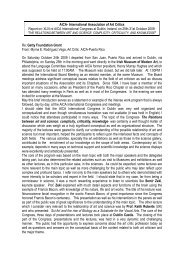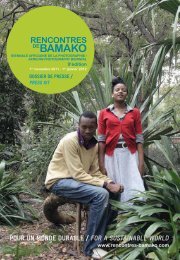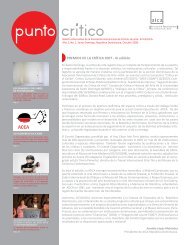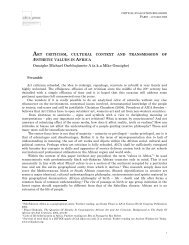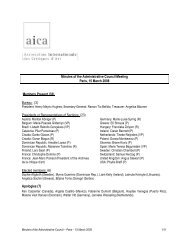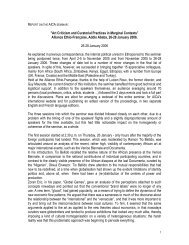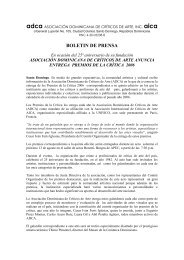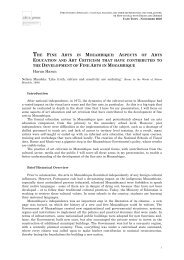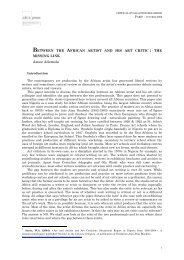Pierre Restany Pierre Restany's - AICA international
Pierre Restany Pierre Restany's - AICA international
Pierre Restany Pierre Restany's - AICA international
Create successful ePaper yourself
Turn your PDF publications into a flip-book with our unique Google optimized e-Paper software.
consacré au Nouveau Réalisme (à paraître chez Ashgate<br />
Press). Elle est également bénéficiaire d’une subvention<br />
de recherche de trois ans du Conseil de recherches en<br />
sciences humaines du Canada afin de poursuivre un projet<br />
sur les collectifs artistiques français et la politique.<br />
Jill Carrick (Ph.D Bryn Mawr College, M.A. University of<br />
Melbourne) is an art-historian and university professor<br />
who works in the area of 20th Century art and interdisciplinary<br />
theory. She teaches at Carleton University in<br />
Canada, and writes on art and intellectual debates in<br />
1960s France. She has published in the British journal<br />
Art history, and is interested in issues of gender, ideology,<br />
and contemporary cultural production. She is<br />
currently working on a book on the French art movement<br />
Le Nouveau Réalisme (to be published by Ashgate<br />
Press). She is also the recipient of a three-year Canadian<br />
government SSHRC research grant to pursue a project<br />
on French collective arts and politics.<br />
Stefano Casciani<br />
Les yeux de <strong>Restany</strong><br />
Pendant 40 ans, <strong>Pierre</strong> <strong>Restany</strong> a été le critique d’art de<br />
la revue Domus et, depuis 1980 et notre rencontre, un<br />
maître à penser pour moi par ses point de vues sur la<br />
relation entre les différentes formes d’expression : peinture,<br />
sculpture, architecture, design, théâtre, musique,<br />
performance, vidéo ont été traduits dans ses textes avec<br />
une remarquable acuité visuelle, une finesse d’esprit<br />
et de langage qui depuis sont demeurées rares dans la<br />
sphère médiatique. Cette communication se veut l’hommage<br />
rendu par un disciple aux qualités extraordinaires<br />
et à l’humanité de <strong>Restany</strong>, dans cette façon qu’il avait<br />
de traiter les problèmes de l’intégration de l’art dans la<br />
vie quotidienne.<br />
<strong>Restany</strong>’s eyes<br />
<strong>Pierre</strong> <strong>Restany</strong> has been for 40 years the art critic of Domus<br />
magazine and, since 1980 when we met, a friend<br />
and a master to me, because of his visions on the relationships<br />
between the forms of expression: painting,<br />
sculpture, architecture, design, theatre, music, performance,<br />
video, have been translated in his writings by the<br />
sharpness of eye, mind and language so hard to find,<br />
since a long time now, in the media scene. As a dedicated<br />
follower of the interconnection between forms of<br />
expression, I will give my talk as an hommage to <strong>Restany</strong>’s<br />
extraordinary qualities and humanity in dealing with<br />
the issue of what’s good in bringing arts to daily life.<br />
Stefano Casciani est un écrivain, designer et artiste né à<br />
Rome en 1955. Il s’installe à Milan en 1979 en tant que<br />
journaliste indépendant et rejoint la revue Domus où il<br />
rencontre <strong>Pierre</strong> <strong>Restany</strong>. En 2000, il devient rédacteur<br />
en chef adjoint du magazine. Après le décès de <strong>Restany</strong>,<br />
il a publié l’ouvrage <strong>Pierre</strong> <strong>Restany</strong>: the Critic as an Artist<br />
(Editoriale Domus, 2004). Il est professeur invité dans<br />
différentes universités et écoles de design et d’architecture<br />
en Italie et de par le monde : ses créations en design<br />
ont été récompensées par le Compasso d’Oro (2001) et<br />
le Prix Lighting for Tomorrow (2003).<br />
Stefano Casciani is a writer, designer and artist, born in<br />
Rome in 1955. He moved to Milan in 1979, as a freelance<br />
editor, to join Domus magazine where he met<br />
<strong>Pierre</strong> <strong>Restany</strong>. In 2000 he became Deputy Editor of the<br />
magazine. After <strong>Restany</strong>’s death, he curated and published<br />
for Editoriale Domus the book <strong>Pierre</strong> <strong>Restany</strong>:<br />
the Critic as an Artist, 2004. He is Visiting Professor in<br />
design and architecture schools and universities in Italy<br />
and abroad: his designs have been awarded with the<br />
Compasso d’Oro (2001) and the Lighting for Tomorrow<br />
Prize (2003).<br />
Annie Claustres<br />
Le rôle de <strong>Pierre</strong> <strong>Restany</strong> dans l’historiographie de<br />
l’art français après-guerre. Le mythe en question.<br />
C’est en 1956 que <strong>Pierre</strong> <strong>Restany</strong> commence à collaborer<br />
à la revue Cimaise. La lecture de ses articles révèle<br />
une conscience de la notion de mythe dans l’opération<br />
historiographique. Attentive aux idéologies et de nature<br />
réflexive, sa prise de position vient ainsi rejoindre<br />
les questionnements de l’historien de l’art qui tente de<br />
mener à bien l’indispensable travail de déconstruction et<br />
de relecture eu égard à l’art français après-guerre. Elle<br />
entre aussi en résonance avec des enjeux intellectuels<br />
importants de son époque. On se souviendra en effet<br />
que Roland Barthes écrivait en 1956 un essai qui fera<br />
date : Le mythe, aujourd’hui.<br />
Questioning the myth: <strong>Pierre</strong> <strong>Restany</strong>’s role in the<br />
historiography of French art in the post-war period.<br />
<strong>Pierre</strong> <strong>Restany</strong> began contributing to the review Cimaise<br />
in 1956. His articles reveal a conscious awareness of the<br />
functioning of myth as part of the historiographical process.<br />
Deeply thoughtful by nature, and alive to issues of<br />
ideology, <strong>Restany</strong> added his voice to those questioning<br />
the role of the art historian, and contemporary attempts<br />
to carry out the essential work of deconstruction and<br />
reinterpretation with regard to post-war French art. His<br />
stance also resonates with key issues in the intellectual<br />
life of his period: 1956 was the year in which Roland<br />
Barthes penned his epoch-making essay, Le mythe,<br />
aujourd’hui.<br />
19


